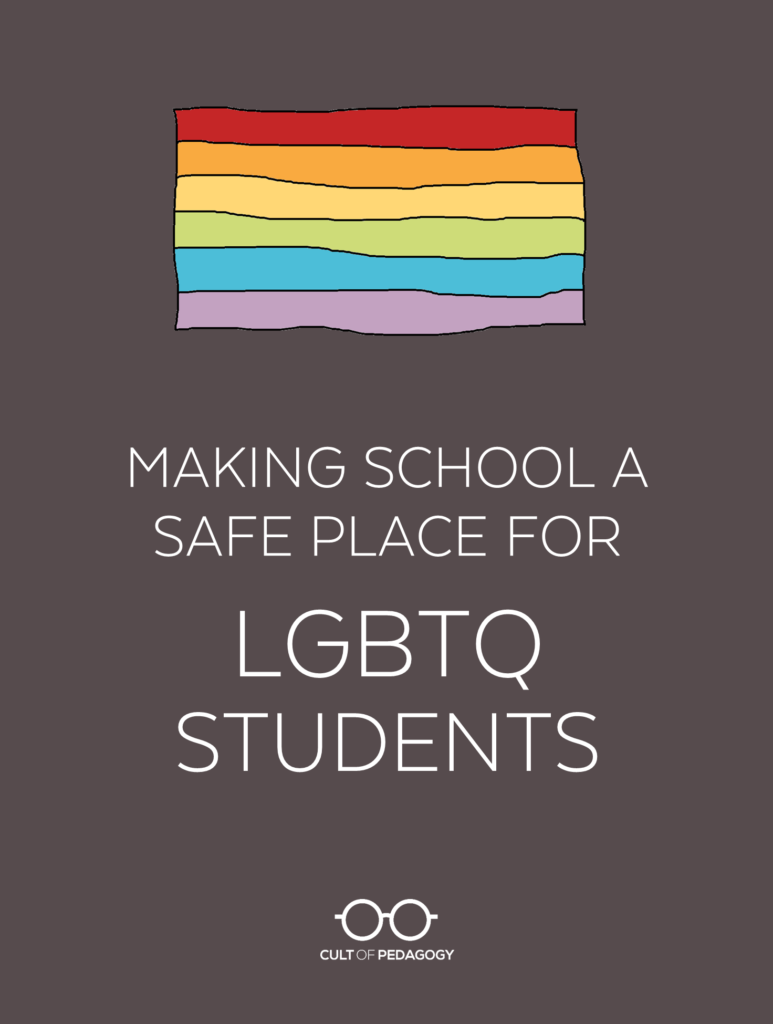
Listen to this post as a podcast:
Proudly sponsored by Write About and Peergrade
Depending on where you live, you might think we’ve reached a point where society has truly embraced people of all gender and sexual identities, making the topic of LGBTQ rights kind of a non-issue. The truth is, for many LGBTQ students, discrimination and harassment are still a daily reality, and school is one of the main places where they experience these things.
A 2015 national school climate study conducted by GLSEN, an organization focused on ensuring safe and affirming schools for LGBTQ students, found that over 85 percent of these students have experienced verbal harassment and 66 percent have been discriminated against based on their sexual orientation or gender identity. As a result of feeling more isolated and unsafe, many of these students miss school, avoid bathrooms, and stay away from locker rooms. Students who experience more victimization are also more likely to have lower GPAs and to report feeling depressed.
And it’s not just other students who create this hostile climate for their LGBTQ peers. Over half of the more than 10,000 students surveyed reported hearing biased remarks from school staff, and school staff often fail to intervene when they hear these remarks at school.
The good news? Overall, the number of students who report being harassed or discriminated against is declining. The climate is improving across the board, but for many students, it’s not happening fast enough.
What Teachers Can Do
As educators, we set the tone for how our students treat each other. No, we can’t control everything, but we can do a lot to influence the climate in our schools and make sure our classrooms are places where all students feel welcome.
The best place to learn more about the specific things you can do is on GLSEN’s website, and I’ve posted two of their best resources for teachers below, but to get you started, I’ve pulled some of the most important steps teachers can take. I also interviewed Becca Mui, GLSEN’s Education Manager, to contribute her insights to the podcast.
These tips, pulled from resources created by GLSEN and my interview with Mui, will give you a good start toward making your school safer and more welcoming for LGBTQ students.
1. Educate Yourself
If you do not personally identify as LGBTQ or spend time in that community, you’ll be a much more effective ally if you commit to listening and learning about the issues. “A huge portion of support is staying educated,” Mui says, “so things like listening to podcasts or just reading some blogs about LGBTQ people and continually learning about that can help you become an ally and an advocate in your school.”
Making an effort to use whatever terminology is currently embraced by the LGBTQ community is another important way to show respect.
“It’s always helpful to have a shared language when you’re talking about identity,” Mui explains. “One of the things that is tricky about LGBTQ and trans identities when people are not part of those communities is that that language is changing, specifically the language we’re using to talk about gender.”
This is a challenge even for people within the LGBTQ community. “It is literally my job to be connected, to be supportive, to know what’s going on,” Mui says, “and I’m constantly finding out that something’s been updated, something’s been changed.” She recommends viewing language as an always evolving process. “Having the attitude that we use the language we have and we are open to learning that something’s been updated can be really useful.”
With that in mind, let’s start here by looking at the acronym LGBTQ:
L = Lesbian
a person who is female-identified who is emotionally or physically attracted to other females
G = Gay
a male-identified person who’s emotionally or physically attracted to other males
In some spaces, the term “gay” is used as a general term to describe the LGBTQ population as a whole, but GLSEN is trying to move toward language that’s more inclusive, rather than placing gay men at the center.
B = Bisexual
a person who is attracted to two genders, or people with your gender and other genders
T = Transgender (or “trans”)
an umbrella term for people whose gender identity doesn’t match the sex they were assigned at birth
The opposite of transgender is cisgender (abbreviated as “cis”), someone whose gender identity is aligned with the one they were assigned at birth.
Q = Queer
also an umbrella term to describe sexual orientation, gender identity, or gender expression that doesn’t conform to heteronormativity
“Historically, (this term) was used as a slur,” Mui says, “but there is a power in re-claimed words, and we find that across different types of marginalized identities, the power to take a word that has been used negatively and say, ‘This is mine’ that a lot of young LGBTQ people are feeling.”
Another term that comes up frequently in discussions of LGBTQ issues is heteronormativity, which is defined by the Queer Dictionary as the belief or assumption that all people are heterosexual, or that heterosexuality is the default or “normal” state of human being. In our schools and our society at large, we often come from a heteronormative place, speaking of the LGBTQ population as the “other,” which communicates to our LGBTQ students that they are deviant or unnatural. We’ll talk more about that a little bit later.
To learn more about terminology and other important issues, download GLSEN’s Safe Space Kit below.
GLSEN Safe Space Kit
A Guide to Supporting Lesbian, Gay, Bisexual
and Transgender Students in Your School
2. Check Your Biases
As with any kind of advocacy, it’s crucial to understand your own background and biases. “All of us, LGBT and non-LGBT, have learned messages about LGBT people,” reads a passage from the Safe Space Kit. “What were the earliest messages you received about LGBT people and where did they come from? Were they positive, negative or neutral? Understanding the messages we receive can help us identify our own beliefs and biases that we can then challenge, helping to make us stronger allies.”
The GLSEN Safe Space Kit provides a “Check Yourself” exercise that will help you take a close look at your own underlying beliefs.
3. Teach Inclusively
The things we teach and how we teach them can send important messages to our students about whether or not they are valued as they are. “So much of our language is gendered in ways that we’re not really thoughtful of,” Mui explains. “Just saying, ‘Boys and girls,’ and not really thinking about who we’re saying that to, or addressing the compliments that we’re giving to students, really thinking about how are we using language, how are we making space in our language for students to identify and be whoever and however they want is a really important step.”
Here are some things you can do to make sure you’re nurturing your LGBTQ students in your instruction:
- Include a variety of gender representations.
When students are presented with a narrow picture of gender roles—and they don’t see themselves in any of them—they develop a sense early on that something is wrong with them. GLSEN’s Ready, Set, Respect! toolkit for elementary teachers (link below) encourages teachers to make sure that classroom books and materials include diverse families and people whose careers and other life roles don’t conform to gender stereotypes. - Group neutrally.
Out of habit, teachers will often divide students into “boy” and “girl” groups. This can make students who don’t conform to gender-based stereotypes feel uncomfortable and isolated. The Ready, Set, Respect! toolkit recommends that instead, we divide students more neutrally by birthday month or by numbering them as 1s and 2s. - Evaluate your speech and materials for heteronormative and gender-normative bias.
In casual conversation, in the examples we use while teaching, and in our materials, we often communicate assumptions about gender and sexuality: Boys are attracted to and will grow up to marry girls (and vice-versa), girls will naturally prefer activities like shopping while boys will naturally be interested in athletics, and so on. All of these send the message that there is only one way to be “normal” and that students who don’t fit these descriptions are abnormal. As you talk, teach, and look at your materials, ask yourself whether you’re communicating these messages, and find ways to replace them with more inclusive examples. - Include positive representations of LGBTQ people in your curriculum.
“Whatever curriculum that is,” Mui says, “there are usually people involved in that, whether that’s the people you’re listing in a math problem or the histories that you’re teaching in a history class, there are ways to bring about diversity. Integrating that into your learning helps all of your students to learn more about the world and it helps LGBTQ students see themselves in their learning.” GLSEN has resources on LGBTQ history that can help with this. As with all resources, teachers should preview these material before offering them to students. GLSEN serves K-12 students, and you will know best which activities and lessons will meet your students’ needs. When sharing facts about LGBTQ history, it’s important for educators to balance a positive influence and celebration of icons and leaders while not hiding the truth behind historically important events.
Ready, Set, Respect!
GLSEN’s Elementary School Toolkit
4. Be Visible
Let your LGBTQ students know that you are an ally by displaying some visible sign of your support. Hanging a rainbow flag or a Safe Space Poster or Sticker in your classroom can accomplish this. GLSEN’s Safe Space Kit points out that this kind of visibility affects students more than we might even realize. “Even if students don’t come to you directly, the kit says, “research shows that just knowing that there is a supportive educator at school can help LGBT students feel better about being in school.”
5. Respond to Anti-LGBTQ Behavior
When students experience harassment in your presence, take action. Simply saying something like “That language is unacceptable,” is enough to acknowledge the act and stop it. The Safe Space Kit includes more detailed information on turning incidents like these into teachable moments and how to respond in more specific situations, like when a student says “That’s so gay.” But the most important thing to remember is to not ignore it. “Remember,” says the Safe Space Kit, “no action is an action — if an incident is overlooked or not addressed it can imply acceptance and approval.”
6. Support Students Who Come Out
As you make yourself more visible as an ally, students may be more likely to come out to you about their sexual orientation or gender identity. This important and sensitive conversation needs to be handled carefully, and the Safe Space Kit offers detailed advice for teachers.
Their most important advice is to listen. Instead of assuming that you know what the student needs or that their situation will be similar to that of other LGBTQ people you have known, treat each student as an individual and just let them talk. Ask them what they need and how you can help. You can give GLSEN’s new Coming Out Resource to students who are thinking of sharing this part of their identity. It may be useful to let students know about hotlines they can call to get out-of-school support. The LGBT National Help Center at glbthotline.org has a collection of numbers that can help.
Remember that this student is trusting you with confidential information that you should not share until they are ready. To be on the safe side, talk to your administrator and guidance counselor about what your school policy says about confidentiality. If it doesn’t go far enough to protect the rights of students, work to change that. Policies regarding confidentiality should also take gender identity into account. GLSEN provides guidelines for these considerations in its Transgender Model District Policy: “It is critical that parental/guardian approval is never a prerequisite for respecting a student’s chosen name, appropriate gender, and pronouns… Staff should take guidance from and work collaboratively with the student to ensure that the student remains safe, both at school and at home.”
7. Support a Student GSA
GLSEN’s research has shown that the existence of a student GSA, or Gender Sexuality Alliance, can go a long way toward improving a school’s climate for LGBTQ students. “Those need to be started by students,” Mui explains, “but asking students if that’s something they want support around” can be a good place to start. A GSA will also need a faculty advisor, so offering your services in that way can make a GSA a reality in your school.
8. Revisit Your School Policies
Making sure that your school’s anti-bullying and anti-discrimination policies include language specific to sexual orientation and gender identity can also improve your school’s climate, and GLSEN’s research has found these types of policies to have significant impact on quality of life for LGBTQ students. Part of your work as an advocate is looking into these policies and working toward real change. Use GLSEN’s Model Policies as a reference: www.glsen.org/modelpolicies.
9. Educate Your Colleagues
Apart from being more vocal and open with your own support for LGBTQ students, you can also conduct your own workshops for colleagues. The Safe Space Kit includes a sample 20-minute presentation teachers can give to school staff. GLSEN also offers in-person professional development. “We are a national organization, but we also have 40 local chapters which are amazingly volunteer-run by humans who are really dedicated and fantastic in this work,” Mui says. “They’re doing this work on the ground, and so we support them here from the national office with resources.” Click here to view a map of local GLSEN chapters.
All of these actions will send a message of love and acceptance to your LGBTQ students—those you know about, and especially those you don’t. Committing yourself to taking even a few of these steps can make such an incredible difference, impacting students’ mental health, their safety, their academic success, and their overall quality of life. It just takes one person to start tipping the scales, to start moving a school culture in a more inclusive direction; I very much hope, for the sake of the students who need you, that you’ll be that person. ♥
ONE MORE RESOURCE: LGBTQ+ youth face more than double the risk of experiencing homelessness compared to their nonqueer-identifying peers. In the last decade, many organizations have formed to help these young adults and children, providing support and resources so they can have somewhere safe and stable to live. To address this issue, Architectural Digest Reviews created this guide to housing assistance for LGBTQ+ youth.
Join my mailing list and get weekly tips, tools, and inspiration—in quick, bite-sized packages—all geared toward making your teaching more effective and fun. You’ll get access to my members-only library of free downloads, including 20 Ways to Cut Your Grading Time in Half the e-booklet that has helped thousands of teachers save time on grading. Come on in!!

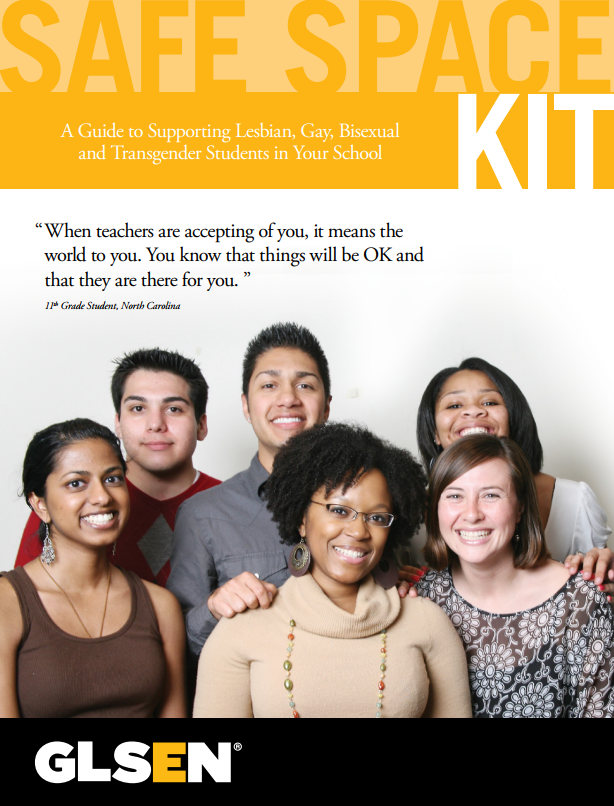
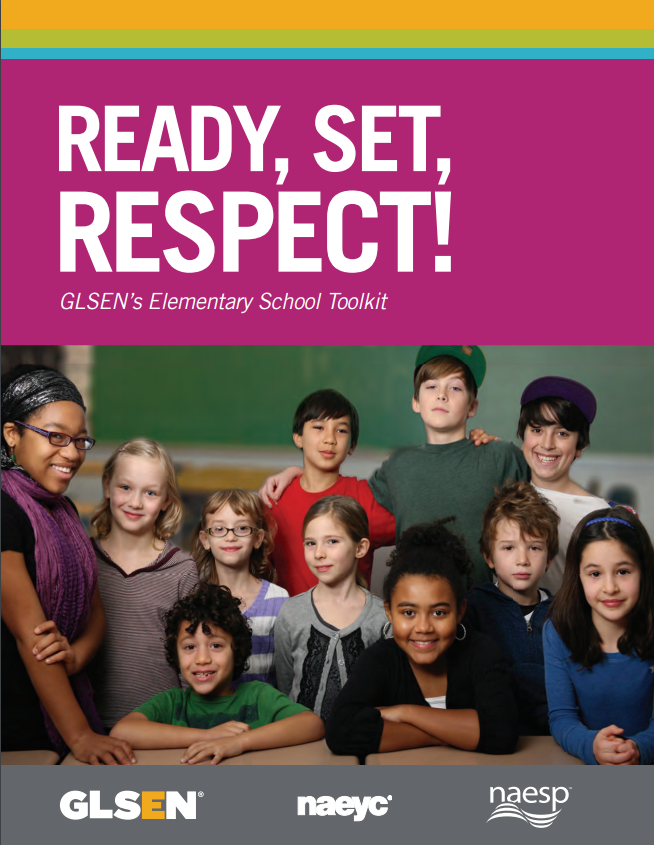


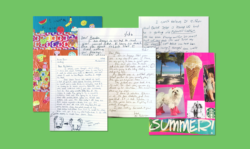
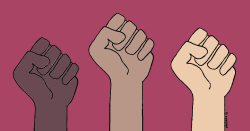
Thank you for posting this! This will reach a large audience.
As you noted, it’s important to check one’s bias. I’ve found the Harvard Implicit Bias tests to be eye-opening. https://implicit.harvard.edu/implicit/takeatest.html
If one is interested in finding quality children’s and young adult books with LGBT+ characters, I recommend the Rainbow List http://glbtrt.ala.org/rainbowbooks/rainbow-books-lists
The Stonewall Book Award has an award for children’s and young adult books, as does the Lambda Book Award. http://www.ala.org/rt/glbtrt/award/stonewall/honored
https://www.lambdaliterary.org/awards/
I am a Safe Zone trainer at a university, and I have done one presentation/training at a recent conference for classroom teachers. I am an assistant professor in an elementary education program. Diversity in children’s literature is one research focus, and LGBT+ issues in education is another research focus.
Thank you for this article. I’m not a teacher but I am older I still want to learn and be better. My view points have changed drastically in my 78 years, about myself and about others. Sometimes ignorance can lead us to do the wrong thing. There are so many social issues that are changing at lightening speed although I know it seems very slow to those who suffer from injustice. Reading articles like this are very helpful to people like me to change old worn out habits.
Thanks so much for sharing this, Norma!
If you are a teacher in a conservative district, how are you succeeding with implementing teachings that develop acceptance and support of LGBTQ students in your classroom? In Canada, LGBTQ rights are protected under the Charter of Rights and Freedoms but individual districts can still place barriers to obtaining access to curriculum supports. The right wing conservative voters in the district argue this doesn’t belong in the public school system because they believe this is a lifestyle *choice* and they should be allowed to prevent their child from having any exposure to these conversations.
You never cease to amaze me with your insights. Grateful you are talking about LGBTQ inclusivity.
You are correct that all teachers have LGBTQ students in their classes whether or not people realize it.
Our first job as teachers is to keep ALL of our students safe.
Thanks for being awesome.
Thanks so much, Connie.
So here is the question that I have. How to be an LGBTQ ally when my school contract doesn’t allow it. I identify as pan but according to the contract that we have to sign with the church (catholic school) we can only promote that marriage is between a man and a woman.
I’m more interested in ways to, let’s just say, creatively get around that without others noticing. For gender stereotypes, I try to use examples where I don’t use pronouns or boys shopping and girls fixing a car and using names that are more neutral (Alex) without using pronouns but am looking for other creative ways to be open without causing too much alarm.
I know a small number of my LGBTQ students (the ones that I know are LGBTQ) and those who don’t follow the strict cultural gender roles have caught on to what I am doing but I want to make more opportunities for all LGBTQ students to see something that I send them under the radar.
Do you have any advice for that?
Hi, AM! Your kids are really fortunate to have you — you’re in a pretty precarious situation, but your empathy and willingness to go “under the radar” to ensure they’re feeling supported is something I’m sure they’re aware of. Sounds like you’re already doing some of the things that are suggested in the post, but unfortunately, based on your contract, you’re pretty limited with what you can do and bring into the classroom. I’m thinking you might want to contact the people at GLSEN to see if they have any other advice specific to your situation. You might also want to scout out Twitter (#LGBTeach) and see if there’s anyone who might jump in with some ideas. Otherwise, I’d just keep doing the kinds of things suggested in the post under Teach Inclusively — there are a couple of bullet points that match what you’re pretty much doing already. Thanks for doing great things for all kids!
Hey, can you provide links to your sources so I can mine them for more information? I’m doing a research inquiry project this semester on how to support transgender students in the classroom. It would be extremely helpful.
Thanks!
Hi Cindy,
Within the post are many linked resources. Was there something you saw specifically that you’re interested in that we can take a look at and help you with? Thanks!
I love this blog post! I think this is a very important and special topic to discuss and it is also a topic that not many people what to talk about… especially, what this topic looks like in a classroom setting! I think it is also important that we are aware that a lot of the students that feel they are being discriminated against, come from educators, and I think this is due to the lack of awareness. I truly belief that educators are responsible for setting the tone as to what the classroom setting will look like! I think that the steps that you provided are steps that should be taken by all educators across the nation for the future students that each educator would get to interact with. Thank you for sharing your knowledge in ways that we can make our classroom and ourselves as educators a save and valued place! This Website will definitely have a bookmark on my device!
PS: Love the Podcast!
Thank you for bringing LGBTQ+ issues to the table! My dad researched this topic in 2004. My husband and I put it online, if you’re interested please have a look at it.
Thank you for sharing this, Amy. We’re glad you found value in the post!